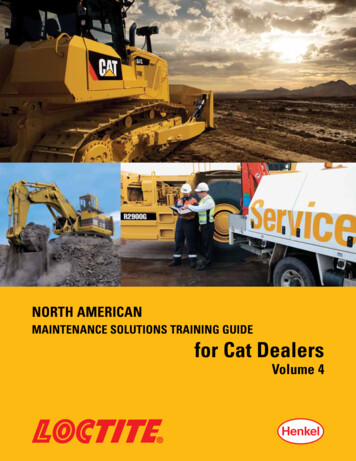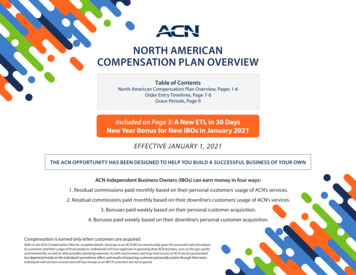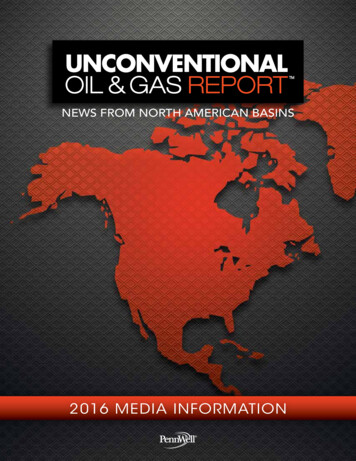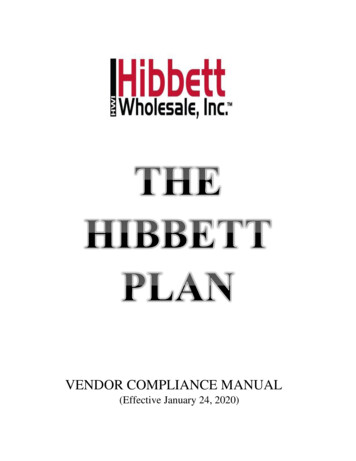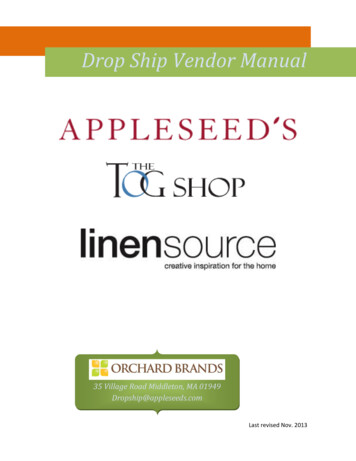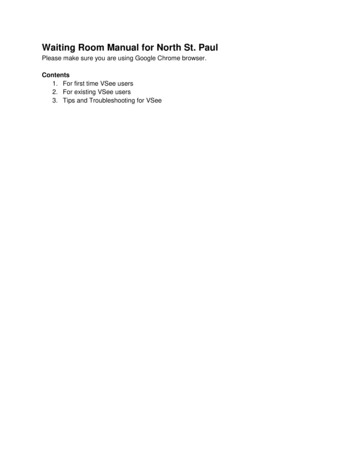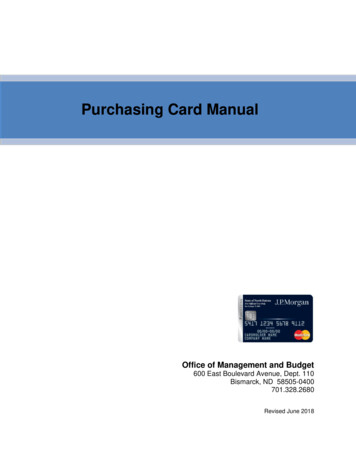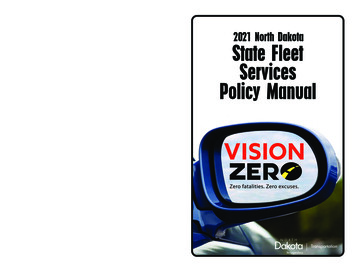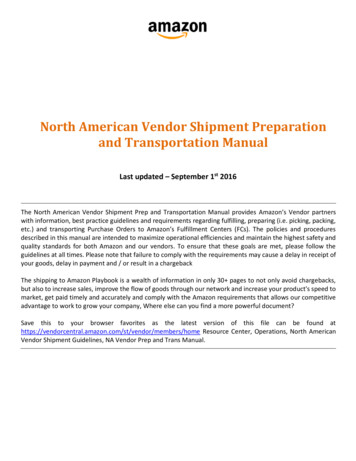
Transcription
North American Vendor Shipment Preparationand Transportation ManualLast updated – September 1st 2016The North American Vendor Shipment Prep and Transportation Manual provides Amazon’s Vendor partnerswith information, best practice guidelines and requirements regarding fulfilling, preparing (i.e. picking, packing,etc.) and transporting Purchase Orders to Amazon’s Fulfillment Centers (FCs). The policies and proceduresdescribed in this manual are intended to maximize operational efficiencies and maintain the highest safety andquality standards for both Amazon and our vendors. To ensure that these goals are met, please follow theguidelines at all times. Please note that failure to comply with the requirements may cause a delay in receipt ofyour goods, delay in payment and / or result in a chargebackThe shipping to Amazon Playbook is a wealth of information in only 30 pages to not only avoid chargebacks,but also to increase sales, improve the flow of goods through our network and increase your product's speed tomarket, get paid timely and accurately and comply with the Amazon requirements that allows our competitiveadvantage to work to grow your company, Where else can you find a more powerful document?Save this to your browser favorites as the latest version of this file can be found rs/home Resource Center, Operations, North AmericanVendor Shipment Guidelines, NA Vendor Prep and Trans Manual.
Table of ContentsSummary of latest changes . 31. Fulfillment of Purchase Order . 32. Packing Inventory . 42.1 Item Packaging . 42.2 Carton Packaging. 52.3 Pallet Building . 63Labeling Inventory . 73.1 General Labeling Requirements . 73.2 Item Labeling . 93.3 Carton Labeling . 113.4 Warning Labels on Cartons . 163.5 Pallet Labels . 174Documents Required for Shipments – Bill of Lading (BOL) . 175Information Required for Shipment - Advanced Shipment Notification (ASN) . 186Transporting your shipments . 206.1 Amazon Paid Freight [Collect / WePay] . 206.2 Vendor Paid Freight [Prepaid / TheyPay] . 216.3 Carrier Appointment Request Portal (CARP) . 227Loading Shipments . 237.1 Floor-Loading . 237.2 Clamp Truck Guidelines. 238Safety and Quality Requirements . 248.1 Trailer/Shipment Safety and Loading Requirements . 248.2 Quality Assurance . 259Returns 2510 International Shipments . 2611 Glossary of Terms . 2612 FAQs 2813 Appendix 1 – BPS Sample (Barcode Packing Slip) . 3214 Appendix 2 – Sample Bill of Lading . 3315 Quick Reference Shipment Checklist . 34 2016, Amazon.com, Inc. or its affiliates. All rights reserved.2
Summary of latest changesVersionRelease DateSection # and Comments9/01/20162.1.5.1 – Tweaked existing information regarding SIOC shipments2.2.2 –Added more information to handle the Prep items3.3.2.4 – Added GTIN14 as a standard carton barcode compliant solutionAddendum 7 – Introduced vendor facing Intermodal loading guidelines5/30/20162.1.5.2 – Addition of SIOC product stack along with illustrative picture example2.2.3 – Updated maximum carton weight and dimensions to avoid chargebacks3.4 – Sample warning labels for ‘team’ / ‘mechanical’ lift and ANSI Z535 standardsAddendum 1 – Addition of Garment on Hanger (GOH) policy and updated prep chargesAddendum 6 – Perfect Inbound Playbook for ASN Match / Accuracy & Efficient Receive2/15/20162.1.5.1 – Specified Ship In Own Container (SIOC) packaging damage standards for teamand mech-lift items2.2.5 – Provided minimum carton dimensions to avoid damage or misplace2.3.6 – Added requirement to keep TVs upright on pallets during shipments2.3.8 – Specified no pallets may be stacked on top of TVs in double stack guidelines3.2.7.2 – New online resource for Apparel vendors instead of the legacy video3.3.2 – Updated GTIN-14 carton labeling section with more details3.4.4 – Added more clarifying information to ‘Sold As Set’ warning stickers7.1.1 – Clarified floor loading guidelines for TVs2015 Q310/19/20152.3.13 – Securing stacked pallets with load bars shown using illustrations3.3.2 – Revised information for compliant carton labels7 – Updated Loading Shipments section (Clamp Truck & Floor loading guidelinesrevised and Slip Sheets section removed)8.1.2 – Reiterated Trailer / Shipment Safety and Loading Requirements2015 Q27/15/20153.3.2 – Table indicating compliant label format to EDI 856 ASN statusEnd of manual – Revamped quick reference shipments checklist2015 Q14/1/20155 – Revised ASN section in tabular form based on new chargeback logic3.2.3 – New text and Master / InnerPack FC pictures with illustrations2016 Q22016 Q12015 Q41. Fulfillment of Purchase OrderEnsure that all terms of the Purchase Order (PO) are met, including:1.1. Exactly the same items (same UPC, EAN, ASIN, ISBN etc.) are being shipped in the same quantities that were ordered andconfirmed. Verify that the unit of measure (individual vs. case, for example) being shipped is consistent with the PO. In case youshipped more quantities than the ones you actually confirmed, a chargeback for Overage will be incurred. It can also lead toASN (Advance Shipment Notification) and receive challenges, resulting in short payments.1.2. Amazon does not accept substitutions or replacement products. Shipped products that were never ordered are subject todisposal, or if received, subject to a chargeback fee and may result in liquidation from inventory. This includes product that wasordered on the PO but we received a quantity in excess of expected quantity (overage). In case of disposal or liquidation,Amazon will not pay vendors.1.3. POs are required to be acknowledged, i.e., accept, reject, or backorder (if allowed) within one day of the order date. It isacceptable for vendors to edit PO confirmation information up to two days after the order date or 14 days before the ASN ShipDate, whichever is later. If you follow this accordingly, you will avoid Late Acknowledgement (accepting PO after one day oforder date) and Confirmation Change (modifying the availability and/or quantity of the PO) chargebacks. Please note that if youedit PO confirmation information within the deadline, new quantities confirmed should never be higher (only equal or lower)than previous quantities confirmed because Amazon could have already ordered the difference from other vendors. 2016, Amazon.com, Inc. or its affiliates. All rights reserved.3
1.4. Accepted PO items are expected to ship or arrive at Amazon within the specified ship/delivery window that is defined in the POheader. The ship/delivery window is defined by Amazon and updating your ESD (Expected Ship Date) / EDD (Expected DeliveryDate) does not extend your ship/delivery window.1.5. An ESD or EDD must be provided every time a backordered PO acknowledgement is submitted. Backordered PO items areexpected to ship or arrive at Amazon within the ESD/EDD provided by the vendor so you avoid ‘Backordered withoutShip/Delivery date’ chargebacks. When some or all of the backordered PO are fulfilled, do not change the originalacknowledgement status.1.6. If you are a collect vendor (Amazon arranges and pays for freight charges), freight must have a routing request freight readydate within the shipping window. Routing requests must be submitted at least one day before freight ready date, no later than10 AM PST for a Static Milk Run. If you are a prepaid vendor (Vendor arranges and pays for freight charges), your carrier mustrequest an appointment date in CARP (Carrier Appointment Request Portal – Section 6.3) that falls within the delivery window.1.7. PO on-time compliance infraction will be incurred if a vendor ships/delivers outside the given window. In-stock managers arenot able to override windows on an ad-hoc basis.1.8. Vendors will incur ‘Unfilled by cancel date’ chargebacks if Amazon has not received the full confirmed quantity for each lineitem on a PO before the PO is auto-cancelled by Amazon systems. The timing of when a PO will auto-cancel is different fordifferent businesses. However, vendors can view their ‘Past Due’ PO Items within Vendor Central by going to Orders PurchaseOrders Update past due PO items.1.9. All units must arrive free of damage or defects (see section 2 for packing instructions to help protect items in transit).1.10. If for any reason you cannot fulfill the exact terms of the PO or you believe terms of the PO were created in error, please opena ‘Contact Us’ feature in Vendor Central or Advantage website with ‘Purchase Order Management’ as Support Topic.2. Packing Inventory2.1 Item Packaging2.1.1 Do not include any unauthorized marketing or promotional materials, such as pamphlets, display materials, price tags and/orother non-Amazon stickers with any items.2.1.2 If you believe any items will require special handling, notify your Retail Representative via the ‘Contact Us’ feature in VendorCentral or Advantage website prior to shipping items.2.1.3 Amazon requires vendors to comply with all applicable Federal, State, and Local laws, rules, regulations, ordinances, anddirectives with respect to product packaging materials. Vendors should direct any related questions to their legalcounsel. Generally, suffocation warnings should be present on all plastic bags (1 mil or less thickness) that have a 5” or greateropening. Meaning, if a bag is thicker than 1mil it will not need suffocation warning label regardless of the designed opening.Required warning language and presentation may vary on the state and local levels. Required warning language andpresentation may vary on the state and local levels. At a minimum, Amazon requires that vendors include a message on plasticbags consistent with the following:WARNING – To avoid danger of suffocation, keep this plastic bag away from babies and children. Do not use this bag in cribs,beds, carriages or play pens. This bag is not a toy.2.1.4 General prep guidelines and special packaging requirements for liquids, sharp items (i.e. cutlery), breakables, perishables,textiles, hazardous materials, batteries etc. can be found in ‘Addendum 1 - Amazon Product Restrictions and Special PackagingInstructions’ document, downloaded with this manual whereas E-commerce ready & frustration free packaging (FFP) detailscan be found in ‘Amazon Packaging Certification Guidelines’ document from Legal section of Vendor Central Resource Center.2.1.5 Heavy and Bulky Products (H/B)2.1.5.1 Cartons are classified as heavy and bulky products if the weight of the carton is more than 150 lbs (68kg) or any of thecarton dimensions are more than 108 inches. These cartons need special handling requirements. Ex: If you have multiboxes flowing to any Non-sort or Special handling network, then all boxes need to be strapped to a pallet.2.1.5.2 Amazon can reject the items (TheyPay) or liquidate (WePay) upon receiving damaged goods or if the criteria is not met.2.1.6 Ship in Own Container (SIOC)2.1.6.1For items, with at least one dimension more than 25’’ or weight in excess of 50.0 lbs/22.7kg or greater, Ship in OwnContainer (SIOC) packaging is required. This means that the item is sent to Amazon in ship-ready packaging, and is ready toship to the customers without any additional protection provided by Amazon. For items over 50 pounds, SIOC containersmust not have holes, rips, water damage, or crushed corners. These damage guidelines applies to carton packaging as well. 2016, Amazon.com, Inc. or its affiliates. All rights reserved.4
2.1.6.2SIOC container must have stack height; total number of same product units that can be vertically stacked withoutdamaging bottom unit.2.1.6.3To verify your package is ready for SIOC you can get the item tested against the ISTA 6-Amazon.com Series 6 TestStandard or ISTA 3A in one of the ISTA labs. The entire list of labs can be found here. Test results to be sent to your RetailRepresentative.2.2 Carton .2.92.2.10The following Sections utilize the term “carton”; however, the same information applies to all types of containers that mighthold individual items, even the direct import shipments that come from overseas to North America.Pack cartons with items relating to only one PO. If cartons must contain items for more than one PO, ship items for no morethan 5 POs per carton and apply ‘Mixed SKU’ warning sticker. For 'Mixed SKU' product, do not mix product that requires PREPor special handling. Doing so reduces the speed of receipt and forces Associates to handle product in the manual environmentvs. electronic receipt.Cartons that contain more than one sellable unit must not weigh more than 50.0 lbs/22.7 kg. Also, cartons must not exceed25” in length, width, or height, unless they contain sellable unit(s) that themselves measure more than 25". Such cartons putAmazon’s FC Associates at risk of injury and FC equipment at risk of damage. You will incur chargebacks for cartons thatexceed these weight/dimension thresholds unless:(a) The carton weighs over 50.0 lbs/22.7 kg because it contains a single sellable unit that itself weighs over 50.0lbs/22.7 kg(Warning labels must be applied, refer to Section 3.4).(b) The carton measures over 25" because it contains one or more sellable units that themselves measure over 25" (Warninglabels must be applied if a carton measuring over 25" weighs more than 35.0 lbs/15.8 kg, refer to Section 3.4).Cartons containing jewelry or watches must be packed to weigh no more than 40.0 lbs/18.2 kg.Cartons sent to Amazon FCs must have a minimum size of 6” x 4” x 1”. This is to prevent your shipments from getting damagedor misplaced during the inbound receive process.Cartons and packing materials (e.g. dunnage, void fill) must sufficiently protect items in transit. As an example of anappropriate carton spec, we use an RSC (regular slotted carton), 32 ECT (edge crush test) or or 200 lb Mullen (burst strength)in B flute. Use of unacceptable packaging materials for shipping products to our fulfillment center will attract chargebacksUse large-sized dunnage, such as air pillows, full sheets ofpaper, sheet foam or bubble wrap. Do not use loose fill ofany kind, such as styrofoam peanuts or shredded paper.Choose a carton size which ensures minimum empty spaceafter items are placed inside it. Space utilization can alsobe maximized by packing multiple units in single cartonwhenever possible (without damaging the items). Thepicture shown is an example of what NOT to do.Cartons must not be bundled using bagging, elastic, tape or extra straps. Do notuse large staple pins or nylon fiber based tapes as they are safety hazards to ourFC associates. Cartons must be staged using standard pallet stacking requirements.Image shown on right is an example of what NOT to do. Please refer to Section 2.3for pallet building requirements.Poly or plastic bags cannot be used as carton. 2016, Amazon.com, Inc. or its affiliates. All rights reserved.5
2.2.112.2.12Cartons that are intended to be sold together (i.e. a set) a total of 100.0 lbs/45.4 kg or greater must be placed on a singlepallet (one sellable unit on each pallet) or be clampable. (See Sections 2.3 for pallet requirements).A single, non-clampable sellable carton or unit (e.g. furniture) weighing 100.0 lbs/45.4 kg or greater should always beindividually palletized. Do not ship items in gaylords (pallet-sized cartons).2.3 Pallet 3.92.3.102.3.11Palletize all LTL and TL shipments. Palletized loads are always preferred; however, Section 7 below presents instructions forfloor loaded shipments. Loaded pallets must have solid, flat tops that can be stacked for better truck utilization with theexception of TV pallets
8.1.2 – Reiterated Trailer / Shipment Safety and Loading Requirements 2015 Q2 7/15/2015 3.3.2 – Table indicating compliant label format to EDI 856 ASN status End of manual – Revamped quick reference shipment

